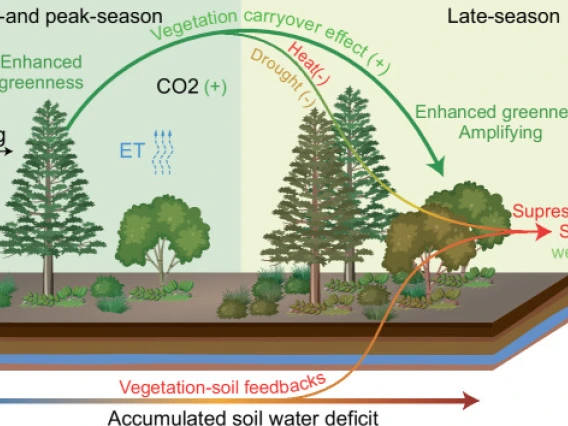Assessing Resilience of Arizona Grasslands to Changes in the North American Monsoon
Goals
Effective rangeland management requires planning for the impacts of climate change. Against a backdrop of rising temperature, the US Southwest is experiencing fewer, larger precipitation events, and longer dry intervals between these events. While abundant research addresses chronic temperature and precipitation shifts, we lack the ability to forecast the impacts of extreme-duration drought on rangeland ecosystem services. There is a critical need for improved prediction of rangeland plant community composition, annual forage production, and seasonal shifts in production timing under this ongoing “temporal repackaging” of rainfall.
To address this knowledge gap, we have constructed a transformative, large-scale, long-term, rainfall manipulation experiment in the Santa Rita Experimental Range (RainManSR). The location provides novel opportunities to study in-depth the impact of extreme-duration drought on soil hydrology, plant community composition, ecosystem function, and total above- and below-ground vegetation production.
Significance
Key ecosystem services provided by Southwest rangelands include wildlife habitat, forage and grazing, soil conservation, and taking up atmospheric carbon, thereby slowing climate change. In particular, Arizona desert rangelands are highly vulnerable to climate extremes. Assessing resilience of grassland biodiversity and forage production to longer droughts will empower ranchers and other land managers to make climate adaptation decisions. This research will also improve our ability to represent climate extremes in operational forecasting tools such as Grass-Cast — a regional decision support tool produced in part by members of our team and used widely by public and private stakeholders. Our long-term goal is decision support to Southwest land managers on grazing rotations and allotments, woody vegetation management, wildlife habitat, wildfire management, agricultural planning, and land restoration. This work addresses multiple AIR themes including (1) Applied Carbon Science and Management, (2) Climate Science, Adaptation and Resilience Solutions; (3) Biodiversity, Conservation & Ecosystems; and (4) Arid Lands & Resources. Because the proposed work will measure mechanisms of grassland response to temporal changes in rainfall, it can readily be scaled to predicting climate resilience across the Southwest.
Issues Involved or Addressed
- We aim to quantify the sensitivity of soil hydrology, ecosystem structure, vegetation productivity, and gas exchange of CO2 and water vapor to temporal repackaging of precipitation.
- Our experiment will also serve as a test bed for the development of sensors and methods to remotely sense ecosystem structure and function under variable climate conditions. We aim to specifically test hyperspectral, thermal, lidar, structure from motion (SfM), and sun-induced fluorescence (SiF) measurement techniques.
- Beyond the primary focus, collaborative opportunities will be encouraged to integrate field and remote sensing data across a collaborative network of ecosystem research sites in the SRER and the broader Western US.
Methods and Tech
Site Infrastructure
- Five hoop-house style rainout shelters (22 m length x 4 m width x 2.5 m height), plus space for 6+ additional shelters in the future.
- Each shelter has 12 plots (1.2 m x 1.5 m) that are hydrologically isolated to a depth of 80 cm.
- Soil moisture sensors installed at 0-10 cm, 25 cm, and 75 cm depths.
- Rainwater harvest systems on each shelter supply irrigation needs and 16,000 L of onsite storage.
- Weighing rain gauge, temperature / relative humidity sensors (ambient and inside one shelter).
- Secure site access, road maintenance, security cameras, local WiFi network, and radio-based remote data access.
Setting within the Santa Rita Experimental Range (SRER)
- Established in 1902, the 21,000 ha Santa Rita Experimental Range (SRER), managed by the University of Arizona, provides unique research and instruction opportunities.
- Eddy covariance flux towers in nearby savanna and grassland ecosystems since 2004 (US-SRM; https://ameriflux.lbl.gov/sites/siteinfo/US-SRM) and 2007 (US-SRG; https://ameriflux.lbl.gov/sites/siteinfo/US-SRG), respectively.
- National Ecological Observatory Core Site (NEON; https://www.neonscience.org/field-sites/srer) since 2012.
- Other long-term SRER data records are available here: https://cals.arizona.edu/SRER/data.html
Academic Majors of Interest
We are a diverse team of researchers, and we seek and are open to student involvement across all majors. Our research objectives are most well aligned with the below fields of study:
- Natural Resources
- Environmental Science
- Hydrology
- Atmospheric Sciences
- Geography
- Geosciences
- Remote Sensing
Preferred Interests and Preparation
- Ability to collaborate with an interdisciplinary team
- Organizational and communication skills
- Creativity and critical thinking skills
- Basic understanding of ecosystem ecology
- Basic statistical/analytical/programming skills
Application Process
To express interest in this team, please complete the VIP Interest Form and select "Assessing Resilience of Arizona Grasslands."
Team Advisors
Nathan Pierce, PhD

Seasonal stabilization effects slowed the greening of the Northern Hemisphere over the last two decades
A new study led by Wen Zhang, with co-authors including William K. Smith, PhD—one of the VIP team leads—uncovers how seasonal stabilization effects are tempering vegetation growth in the Northern Hemisphere despite increased CO₂ levels and warmer spring temperatures.
Using MODIS satellite data, the research shows that in over 90% of ecosystems above 30°N, early-season plant growth does not continue into the late season. Instead, drought, heat stress, and soil moisture loss limit sustained greening, challenging existing climate models that often overestimate the land carbon sink.
These findings underscore the importance of accounting for late-season stressors in climate modeling and ecosystem forecasting.

